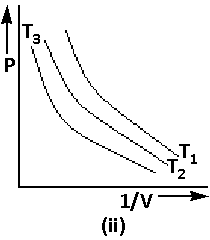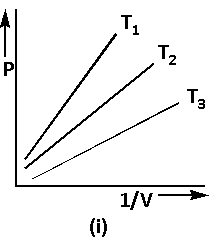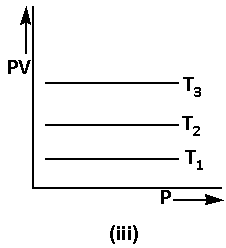
Graphs between pressure and volume are plotted at different temperatures. Which of the following isotherms represents Boyle’s law as ${\text{PV}} = {\text{Constant}}$?

A) Only (ii) is a correct representation of Boyle’s law.
B) Only (iv) is the correct representation of Boyle’s law.
C) All are correct representations of Boyle’s law.
D) None of these representations is correct for Boyle’s law.

Answer
548.4k+ views
Hint: To solve this we must know Boyle's law. Boyle’s law states that at constant temperature the volume of an ideal gas is inversely proportional to the pressure of the gas.
Complete step by step answer:
We know that Boyle's law states that at constant temperature the volume of an ideal gas is inversely proportional to the pressure of the gas.
The expression for Boyle’s law is as follows:
${\text{P}} \propto \dfrac{1}{{\text{V}}}$ …… (1)
Where ${\text{P}}$ is the pressure,
${\text{V}}$ is the volume.
Using equation (1), the graph of Boyle’s law is as follows:

The equation (1) can be written as follows:
${\text{P}} = {\text{K}}\dfrac{1}{{\text{V}}}$ …… (2)
Where ${\text{K}}$ is the constant.
Using equation (2), the graph of Boyle’s law is as follows:

We are given that ${\text{PV}} = {\text{Constant}}$. Thus,
${\text{PV}} = {\text{K}}$ …… (3)
The equation (3) can also be written as follows:
${\text{PV}} = \dfrac{{\text{K}}}{{\text{P}}} \times {\text{P}}$ …… (4)
Using equation (4), the graph of Boyle’s law is as follows:

The equation (2) can be written in the form of log as follows:
${\text{log P}} = - \log {\text{ V}} + \log {\text{ K}}$ …… (5)
Using equation (5), the graph of Boyle’s law is as follows:

From the above graphs, we can say that all the graphs are the correct representations of Boyle’s law.
Thus, the correct option is (C).
Note: We know that Boyle's law states that at constant temperature the volume of an ideal gas is inversely proportional to the pressure of the gas. Thus, as the volume of the gas increases, the pressure decreases or as the volume of the gas decreases, the pressure increases.
Complete step by step answer:
We know that Boyle's law states that at constant temperature the volume of an ideal gas is inversely proportional to the pressure of the gas.
The expression for Boyle’s law is as follows:
${\text{P}} \propto \dfrac{1}{{\text{V}}}$ …… (1)
Where ${\text{P}}$ is the pressure,
${\text{V}}$ is the volume.
Using equation (1), the graph of Boyle’s law is as follows:

The equation (1) can be written as follows:
${\text{P}} = {\text{K}}\dfrac{1}{{\text{V}}}$ …… (2)
Where ${\text{K}}$ is the constant.
Using equation (2), the graph of Boyle’s law is as follows:

We are given that ${\text{PV}} = {\text{Constant}}$. Thus,
${\text{PV}} = {\text{K}}$ …… (3)
The equation (3) can also be written as follows:
${\text{PV}} = \dfrac{{\text{K}}}{{\text{P}}} \times {\text{P}}$ …… (4)
Using equation (4), the graph of Boyle’s law is as follows:

The equation (2) can be written in the form of log as follows:
${\text{log P}} = - \log {\text{ V}} + \log {\text{ K}}$ …… (5)
Using equation (5), the graph of Boyle’s law is as follows:

From the above graphs, we can say that all the graphs are the correct representations of Boyle’s law.
Thus, the correct option is (C).
Note: We know that Boyle's law states that at constant temperature the volume of an ideal gas is inversely proportional to the pressure of the gas. Thus, as the volume of the gas increases, the pressure decreases or as the volume of the gas decreases, the pressure increases.
Recently Updated Pages
Master Class 12 Business Studies: Engaging Questions & Answers for Success

Master Class 12 Economics: Engaging Questions & Answers for Success

Master Class 12 English: Engaging Questions & Answers for Success

Master Class 12 Maths: Engaging Questions & Answers for Success

Master Class 12 Social Science: Engaging Questions & Answers for Success

Master Class 12 Chemistry: Engaging Questions & Answers for Success

Trending doubts
What is meant by exothermic and endothermic reactions class 11 chemistry CBSE

Which animal has three hearts class 11 biology CBSE

10 examples of friction in our daily life

One Metric ton is equal to kg A 10000 B 1000 C 100 class 11 physics CBSE

1 Quintal is equal to a 110 kg b 10 kg c 100kg d 1000 class 11 physics CBSE

Difference Between Prokaryotic Cells and Eukaryotic Cells




